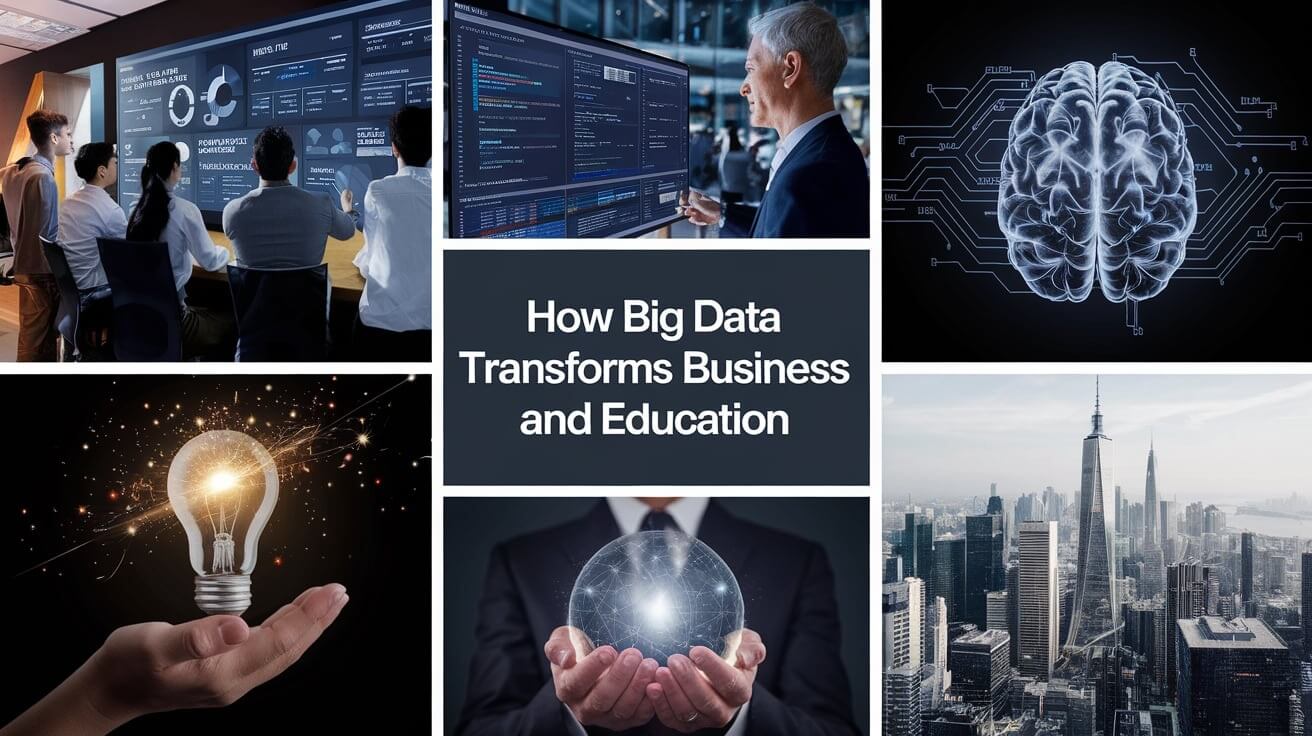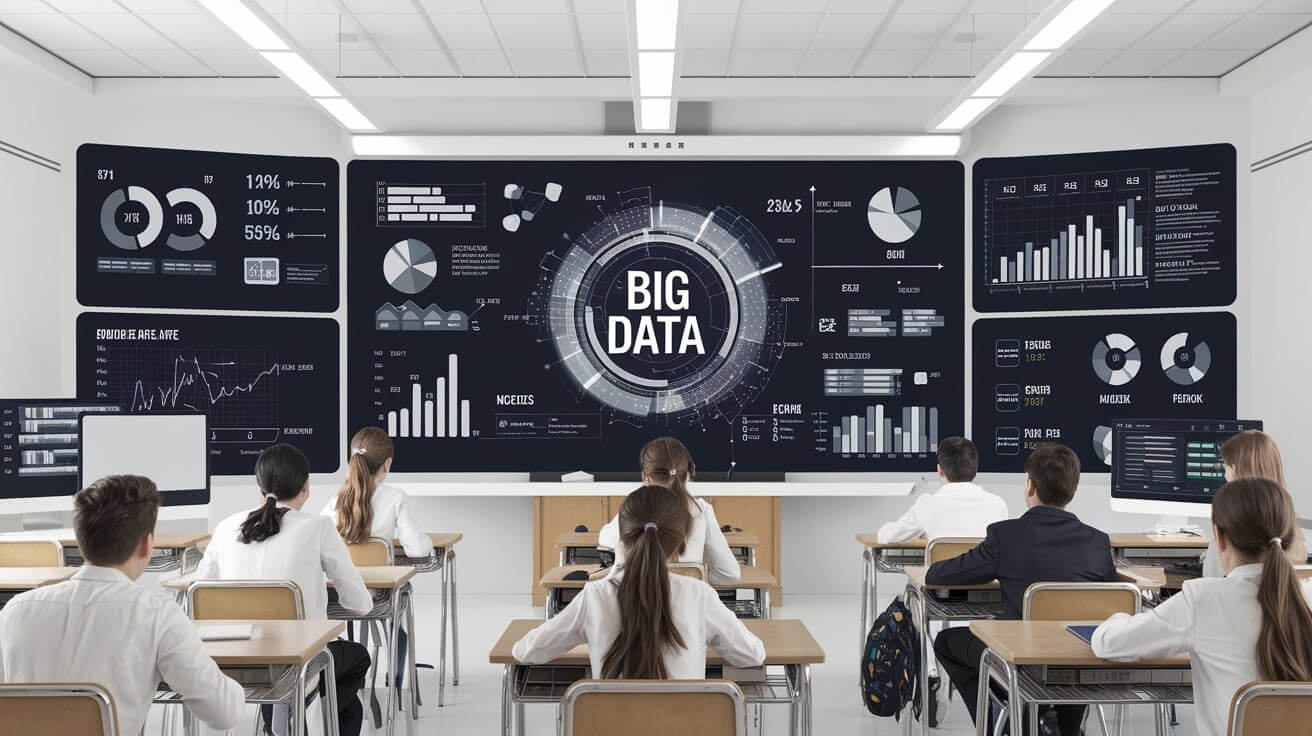
How Big Data is Used in Business and Education
Introduction:
Have you ever wondered how companies and schools make sense of all the data they collect? Big data isn't just a tech term; it's a powerful tool changing how we approach everything from business strategy to classroom teaching.
Big data allows businesses to anticipate trends, enhance customer experiences, and boost productivity. On the other hand, educational institutions are using data to personalize learning and track student progress in unprecedented ways.
This article will explore how big data is used in business and education. Whether leading a company, working in education, or intrigued by data's potential, you'll gain valuable insights into how big data can make a real difference.
Big Data in Business: Making Smarter Decisions

Why Big Data Matters for Today's Businesses
Big data is at the heart of modern business. It's a valuable resource that enables companies to gain insights into their customers, streamline operations, and mitigate risks.
Here's how businesses are using big data to get ahead:
- Customer Insights: Data allows businesses to understand customers' wants, helping them predict buying patterns and improve satisfaction.
- Operational Efficiency: Businesses can spot inefficiencies and reduce costs by analyzing workflows and processes.
- Risk Management: With predictive models, companies can foresee potential risks and take preventive measures.
Real-Life Applications of Big Data in Business
- Retail: Retail giants like Amazon and Walmart use data analytics to track customer preferences, optimize inventory, and improve customer service.
- Healthcare: Hospitals and clinics use data for everything from patient diagnosis to designing personalized treatment plans.
Quick Fact: 91.7% of top companies are investing in big data and AI to stay competitive, according to a NewVantage Partners survey.
Key Benefits of Big Data in Business
- Better Decisions: Data gives leaders the insights they need to make informed choices.
- Competitive Advantage: Companies can stay competitive by staying alert to market changes and truly understanding their customers' needs.
- Targeted Marketing: Big data enables businesses to create campaigns that reach the right people at the right time.
Big Data Challenges in Business
Of course, big data comes with its own set of challenges. Issues like data privacy, high infrastructure costs, and the need for specialized skills make it challenging for some businesses to leverage big data fully.
Big Data in Education: Enhancing learning outcomes

Transforming Education with Big Data
In education, big data is a game-changer. It helps schools and universities understand how students learn and where they need help. Here's how big data is shaping the future of education:
- Personalized Learning: Teachers can tailor lessons based on each student's strengths, weaknesses, and learning styles.
- Predictive Analytics: Schools can track student performance and identify at-risk students early, helping them get the support they need.
- Efficient Resource Allocation: Data analytics help schools manage resources efficiently, ensuring budgets are used where needed most.
Case Example:
Some universities use data analytics to track attendance and engagement, helping them support students at risk of falling behind.
Benefits of Big Data in Education
- Better Engagement: Personalized learning keeps students more interested and motivated.
- Data-Driven Curriculum: Teachers can refine their lessons based on data insights.
- Streamlined Administration: From admissions to finance, big data simplifies school operations.
Big Data Challenges in Education
Educational institutions face unique challenges, especially those related to student data privacy and the cost of setting up data analytics systems.
Success Stories of Big Data: Business and Education
Real-World Examples of Big Data Success
- Netflix: This streaming giant analyzes viewer preferences using big data and makes personalized recommendations that engage users.
- Georgia State University: Through predictive analytics, the university has raised its graduation rates by proactively supporting at-risk students.
Implementing Big Data: A Step-by-Step Guide for Businesses and Teachers

Integrating big data into your operations—whether in a business setting or an educational institution—can initially feel overwhelming. It devides into practical steps can make it easier to start gaining real value from data-driven insights. Below is a guide that tailors big data strategies for business leaders and teachers, aiming to make the implementation process smooth, practical, and impactful.
Step 1: Define Clear Goals
The first step is to clarify what you want to accomplish with big data. Knowing your end goals will guide every decision, from the tools you choose to the data you collect.
- For Businesses: Your goal might be to enhance customer experience, streamline operations, or improve risk management. Defining these objectives helps focus your data efforts and align them with the broader business strategy.
- For Educators: Think about what data could do to improve student outcomes. Do you want to personalize learning experiences, identify at-risk students, or streamline administrative tasks? Clearly defining these goals will ensure your data efforts support better educational outcomes.
ð¡Tip:
Please write down your goals and make them as specific as possible. For instance, instead of "improving student engagement," aim to "increase student engagement in remote learning by 20% over the next year."
Step 2: Invest in the Right Tools
With your goals in mind, it's time to choose data analytics tools that align with your needs. Different tools offer unique features, so choose those that best support your objectives.
- Suggested Tools:
- Google Analytics: Great for tracking user engagement, prevalent in businesses and education sectors.
- Tableau: A powerful visualization tool for turning raw data into easily interpretable charts and graphs.
- Microsoft Power BI: Known for its accessibility and ease of integration, it is ideal for those just starting with data analytics.
- Special Consideration for Educators: Look into education-specific analytics platforms like BrightBytes or Ed-Fi. These platforms are tailored to educational settings and focus on tracking student performance and engagement.
ð¡ Tip:
Before investing, try different tools through free trials to determine which best suits your needs and team skill level.
Step 3: Foster a Data-Literate Culture
A tool is only as good as the people using it. Building a data-literate culture ensures that everyone on your team—from executives to teachers—understands how to interpret and act on data insights.
- Encourage Training: Invest in workshops or online courses to upskill your team in data literacy. Platforms like Coursera, Udemy, or LinkedIn Learning offer data analysis and interpretation courses.
- Make Data Accessible: Ensure data isn't just for the IT department. Team members across departments or educational roles should feel confident accessing and using data to inform decisions.
- For Teachers: If you're an educator, introducing data concepts to teaching staff can open new ways to monitor student progress. Training on using analytics dashboards can help teachers spot trends and tailor their approach to individual students.
ð¡ Tip:
Encourage a mindset of curiosity and experimentation. Let team members explore data and share insights that could contribute to achieving collective goals.
Step 4: Prioritize Privacy and Data Security
With excellent data power comes great responsibility. Privacy is critical, especially when handling sensitive customer or student data. Establishing strong privacy practices builds trust and aligns with regulatory requirements.
- Data Security Practices:
- Encryption: Secure data by encrypting it both during transmission and storing it.
- Access Control: Limit data access to only those who need it for their roles, using role-based permissions.
- Regular Audits: Regularly perform audits to verify adherence to privacy laws and internal policies.
- For Educators: Student data is sensitive and must be handled carefully. Follow privacy guidelines, such as FERPA in the U.S., which protects student information. Parents and students should feel confident that their data is secure.
ð¡ Tip:
Establish a clear data privacy policy and communicate it openly with your stakeholders, whether they're customers, students, or parents.
Step 5: Start Small and Scale Over Time
When implementing big data, starting with a manageable pilot project is wise. Small-scale efforts allow you to test the waters, gain insights, and adjust before a full-scale rollout.
- Choose a Focus Area: Select one area that will benefit from data-driven insights, such as customer feedback analysis for businesses or attendance tracking for educational institutions.
- Measure Outcomes: Track the impact of your initial efforts. Did data-driven decisions improve your focus area? Use these insights to refine your approach before expanding.
ð¡ Tip:
Building on small successes will give your team confidence and provide a foundation for expanding your data initiatives.
Conclusion:
Big data has the potential to revolutionize both business and education. Companies can enhance customer experiences with data-driven decisions, while schools can help students learn more effectively. As big data tools and strategies evolve, they'll become an even more significant part of our lives, guiding smarter choices and personalized experiences.
If you're involved in business or education, now's the perfect time to start thinking about how you can leverage big data to meet your goals. The possibilities are endless, and the benefits are real.
Takeaway:
Embracing big data may feel overwhelming, but starting small and prioritizing training can make a significant impact. Begin your data journey today, and see how it can transform your organization's future.
FAQ
1. What are some examples of big data in business?
Big data is widely used in customer analytics, supply chain management, and marketing personalization.
2. How is big data applied in education?
Schools use big data for personalized learning, tracking student progress, and allocating resources effectively.
3. What challenges come with big data?
Some common challenges include data privacy concerns, high setup costs, and the need for specialized skills.
4. How can small businesses benefit from big data?
Small businesses can leverage data insights for targeted marketing and better customer service, even with limited resources.
5. Is big data safe?
Big data is generally safe when handled with solid security measures, although privacy risks still exist.
Technology Information Technology

